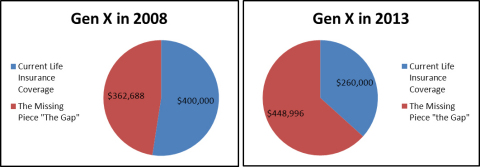NEW YORK--(BUSINESS WIRE)--A unique pair of national surveys looking at life insurance protection conducted before and after the Great Recession finds Americans’ gap in protection has worsened considerably, and Gen Xers have been the most severely impacted.
Before the Great Recession took solid hold in 2008, Gen Xers reported a median shortfall between their life insurance coverage and their self-described financial needs of $362,688. Today, they are reporting a $448,996 ‘Gap’ – an increased chasm of 24 percent, putting them in even greater danger of missing widely-held goals such as paying off mortgage or credit card debt, funding a four year college education, or financing a secure retirement because they lack adequate life insurance protection.
A new Life Insurance Gap survey examined the financial planning attitudes and behaviors of 1,000 Americans age 25 and over with dependents. It focused on how much life insurance coverage Americans had in place and what they want their life insurance policies to cover in the event of the death of the breadwinner, resulting in a self-reported Gap. Both the 2008 and 2013 Gap surveys were commissioned by New York Life, the nation’s largest mutual life insurer.
|
A Widening Gap for Gen Xers |
|||||||||||||||
| Year |
Median Amount of Life |
Amount Needed to |
Coverage Gap | ||||||||||||
| 2013 | $260,000 | $708,996 | $448,996 | ||||||||||||
| 2008 | $400,000 | $762,688 | $362,688 | ||||||||||||
Click here to view pie charts representing this data.
“Gen Xers have been severely impacted by the economic downturn and the Gap is a clear indication of what is at risk. Gen Xers, who may be focused on financial obligations that have to do with their children, their home, planning for retirement, and maybe even taking care of their elderly parents, are lacking a foundation of financial protection that life insurance provides,” said Chris Blunt, president of the Insurance Group, New York Life. “The good news is that Gen Xers, who are in their prime earning years, are in a position to plug the Gap. For the cost of a flat screen TV, Gen Xers would be providing a key element of protection for their family.”
Key findings from the Life Insurance Gap survey include:
- From 2008 to 2013, there has been a 35 percent decline in life insurance coverage in place for Gen Xers, from $400,000 to $260,000;
- The Gap impacts more than half (56%) of Gen Xers, and less than one in five (19%) stated they have enough life insurance to cover everything they expect their insurance to pay for.
“This study took a novel approach by asking respondents what they want insurance to cover and comparing it to the coverage they have in place. It shows Americans that it’s not the life insurance industry telling them they need more coverage – consumers themselves are saying they need it,” said J. Walker Smith, executive chairman, The Futures Company, which conducted the survey.
Generation Stress℠ – The Gap Is Especially Punishing for Gen X
The Gap for Generation Xers is $448,996, which is 40 percent greater than the median Gap for all Americans and significantly higher than other age groups.
|
Median Amount of Life |
Amount Needed to |
Life Insurance |
|||||||||||||
| Total Sample | $220,000 | $540,000 | $320,000 | ||||||||||||
| Millennials | $200,000 | $570,744 | $370,744 | ||||||||||||
| Gen X | $260,000 | $708,996 | $448,996 | ||||||||||||
| Boomers | $200,000 | $467,016 | $267,016 | ||||||||||||
“What this study makes clear is that the cost of doing nothing can be enormous at any age, but Gen Xers are clearly most at risk and most exposed by inadequate life insurance coverage,” said Mr. Blunt. “This five year comparison study brings the challenges that Gen X is facing into stark relief, and hopefully will help add to a broader national conversation about how this generation can protect what it has and build for the future.”
Survey Methodology
The 2013 survey was conducted by The Futures Company, an independent third party research company. A total of 1,004 (unweighted) nationally representative online surveys were conducted from April 24 to May 1, 2013. Participants had to be at least 25 years of age, married or with financial dependents and/or have sole or shared household financial decision making power, and had to have annual household income of at least $50,000.
The 2008 survey was conducted by the independent research firm Greenwald & Associates. A telephone survey of 1,003 consumers was conducted in May 2008. Participants had to be at least 25 years of age, married and/or responsible for the support of their children, and had to have annual household incomes of $50,000 or more. The sample was evenly split between men and women. In a similarly-sized random sample survey, the margin of error at the 95% confidence level for the 1,003 consumers surveyed is plus or minus 3.1%.
Gap Calculation
According to the survey, Gen X breadwinners reported a median of approximately $260,000 in life insurance coverage. Respondents were then asked about the ways they planned to use their families’ life insurance coverage if needed. Options ranged from simply replacing the breadwinner’s income to covering retirement and college expenses. Based on the responses to these questions, the median amount respondents reported they would need from the breadwinner’s life insurance proceeds was $708,996. When contrasted with the $260,000 median amount of actual life insurance coverage, the typical Gen X American family faces a 63 percent gap between their financial goals and the money they would have available from their life insurance policies in the event of the breadwinner’s death.
In 2008, Gen X breadwinners reported a median of approximately $400,000 in life insurance coverage, and the median amount respondents reported they would need from the breadwinner’s life insurance proceeds was $762,688. When contrasted with the $400,000 median amount of actual life insurance coverage, the typical Gen X family faced a 48 percent gap between their financial goals and the money they would have available from their life insurance policies in the event of the breadwinner’s death.
About New York Life
New York Life Insurance Company, a Fortune 100 company founded in 1845, is the largest mutual life insurance company in the United States* and one of the largest life insurers in the world. New York Life has the highest possible financial strength ratings currently awarded to any life insurer from all four of the major credit rating agencies: A.M. Best (A++), Fitch (AAA), Moody’s Investors Service (Aaa), Standard & Poor’s (AA+).** Headquartered in New York City, New York Life’s family of companies offers life insurance, retirement income, investments and long-term care insurance. New York Life Investments*** provides institutional asset management and retirement plan services. Other New York Life affiliates provide an array of securities products and services, as well as retail mutual funds. Please visit New York Life’s website at www.newyorklife.com for more information.
*Based on revenue as reported by “Fortune 500 ranked within Industries, Insurance: Life, Health (Mutual),” Fortune magazine, May 20, 2013. See http://money.cnn.com/magazines/fortune/fortune500/2013/faq/?iid=F500_sp_method%20 for methodology.
**Individual independent rating agency commentary as of 8/1/13.
***New York Life Investments is a service mark used by New York Life Investment Management Holdings LLC and its subsidiary, New York Life Investment Management LLC.
Generation Stress is a service mark of New York Life Insurance Company.




